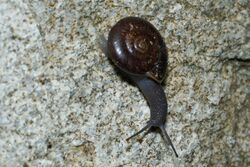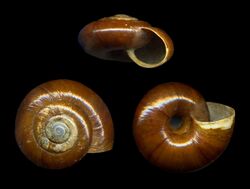Biology:Glyptostoma gabrielense
| Glyptostoma gabrielense | |
|---|---|

| |
| Scientific classification | |
| Kingdom: | Animalia
|
| Phylum: | |
| Class: | |
| (unranked): | clade Heterobranchia
clade Euthyneura
clade Panpulmonata clade Eupulmonata clade Stylommatophora informal group Sigmurethra |
| Superfamily: | |
| Family: | |
| Genus: | |
| Species: | G. gabrielense
|
| Binomial name | |
| Glyptostoma gabrielense Pilsbry, 1938
| |
Glyptostoma gabrielense, commonly known as the San Gabriel chestnut or San Gabriel chestnut snail, is a species of air-breathing land snail in the family Megomphicidae. It is found in the San Gabriel Mountains, including in Angeles National Forest and San Gabriel Mountains National Monument, as well as historically in lowlands in parts of the Los Angeles Basin.
Description
Glyptostoma gabrielense is a medium species of snail, with the flattened disk-like shell spanning approximately 30 millimetres (1.2 in) across and 14 millimetres (0.55 in) high.[1] The shell is dark chestnut brown in color and the snail's body is dark gray.

Distribution and habitat
Glyptostoma gabrielense is native to a narrow strip of the front range of the San Gabriel Mountains about 15 miles (24 km) long near Pasadena, California, where it inhabits riparian canyons and other areas with sufficient seasonal moisture. It was historically also found in the Dominguez Hills to the south; this population has since been extirpated.[2] Prior to the extensive development and habitat clearing that took place in the lower elevations of the San Gabriel Valley, this species was likely found there as well.
Ecology
The small range occupied by Glyptostoma gabrielense represents a portion of the California Floristic Province, and as such this species' habitat experiences a Mediterranean climate involving extremely dry summers with almost no precipitation. During wet conditions during the cooler months, G. gabrielense is able to move on the surface. During the dry season (usually June through October), this species aestivates underground.
Like other Glyptostoma snails, G. gabrielense feeds on decomposing plant material as well as fungi and bacteria involved in the decomposition process.[3]
References
- ↑ Pilsbry, H.A. 1938. A new species of Glyptostoma. Proceedings of the Academy of Natural Sciences of Philadelphia 90:25.
- ↑ Courtney, B.J. 2016. Comments on the Notice of Community Meeting/Scoping for Tentative Tract Map No. 73567 Oak View Estates Specific Plan, City of Bradbury, Los Angeles County (SCH # Not Issued). Letter from California Department of Fish and Wildlife to Anne McIntosh, City Planner, City of Bradbury. December 14, 2016.
- ↑ Cox, G.W. 1982. The importance of being flat. Environment Southwest,San Diego Society of Natural History 498: 9‐11.
Wikidata ☰ Q3078445 entry
 |

